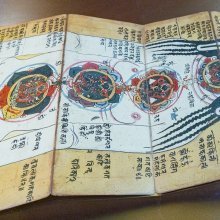Nati, Ñāti, Naṭī: 22 definitions
Introduction:
Nati means something in Buddhism, Pali, Hinduism, Sanskrit, Marathi, Hindi, biology, Tamil. If you want to know the exact meaning, history, etymology or English translation of this term then check out the descriptions on this page. Add your comment or reference to a book if you want to contribute to this summary article.
Images (photo gallery)
In Hinduism
Vyakarana (Sanskrit grammar)
Source: Wikisource: A dictionary of Sanskrit grammarNati (नति).—Lit.inclination, bending down; the word is used generally in the technical sense of 'cerebralization' but applied to the change of न् (n) into ण् (ṇ) as also that of स् (s) into ष् (ṣ); cf. दन्त्यस्य मूर्धन्यापत्तिर्नतिः (dantyasya mūrdhanyāpattirnatiḥ), V. Pr.I. 42. The root नम् (nam) is used in the sense of 'cerebralizing ' or 'being cerebralized' very frequently in the Pratisakhya works; e.g. the word नम्यते (namyate) is used in the sense of 'is cerebralized'; नमयति (namayati) in the sense of 'cerebralizes' and नामिंन् (nāmiṃn) in the sense of 'causing cerebralization'; cf. ऋकारादयो दश नामिनः स्वराः, पूर्वो नन्ता नतिषु नम्यमुत्तरम् (ṛkārādayo daśa nāminaḥ svarāḥ, pūrvo nantā natiṣu namyamuttaram) R. Pr. I. 27.

Vyakarana (व्याकरण, vyākaraṇa) refers to Sanskrit grammar and represents one of the six additional sciences (vedanga) to be studied along with the Vedas. Vyakarana concerns itself with the rules of Sanskrit grammar and linguistic analysis in order to establish the correct context of words and sentences.
Jyotisha (astronomy and astrology)
Source: Wikibooks (hi): Sanskrit Technical TermsNati (नति).—1. Meridian zenith distance or the R sine of that. 2. Difference between the parallaxes in latitude of the Sun and the Moon i.e., latitudinal parallax. Note: Nati is a Sanskrit technical term used in ancient Indian sciences such as Astronomy, Mathematics and Geometry.

Jyotisha (ज्योतिष, jyotiṣa or jyotish) refers to ‘astronomy’ or “Vedic astrology” and represents the fifth of the six Vedangas (additional sciences to be studied along with the Vedas). Jyotisha concerns itself with the study and prediction of the movements of celestial bodies, in order to calculate the auspicious time for rituals and ceremonies.
In Buddhism
Tibetan Buddhism (Vajrayana or tantric Buddhism)
Source: Wisdom Library: Tibetan BuddhismNaṭī (नटी) is the name of Vidyārājñī (i.e., “wisdom queen”) mentioned as attending the teachings in the 6th century Mañjuśrīmūlakalpa: one of the largest Kriyā Tantras devoted to Mañjuśrī (the Bodhisattva of wisdom) representing an encyclopedia of knowledge primarily concerned with ritualistic elements in Buddhism. The teachings in this text originate from Mañjuśrī and were taught to and by Buddha Śākyamuni in the presence of a large audience (including Naṭī).
Source: academia.edu: The Structure and Meanings of the Heruka Maṇḍala1) Naṭī (नटी) refers to one of the twenty-four Ḍākinīs positioned at the padma (lotus) in the middle of the Herukamaṇḍala, according to the 10th century Ḍākārṇava chapter 15. Accordingly, between the west and south (of the heruka-maṇḍala) are six Ḍākinīs who are half red and half yellow in color. They [viz., Naṭī] are headed by the major four Ḍākinīs of the Cakrasaṃvara tradition. They stand in the Pratyālīḍha posture and, except for the body posture, their physical features and objects that they hold are the same as Vajravārāhīs.
2) Naṭī (नटी) is the name of a Ḍākinī who, together with the Vīra (hero) named Naṭa forms one of the 36 pairs situated in the Guṇacakra, according to the same work. Accordingly, the guṇacakra refers to one of the four divisions of the sahaja-puṭa (‘innate layer’), situated within the padma (lotus) in the middle of the Herukamaṇḍala. The 36 pairs of Ḍākinīs [viz., Naṭī] and Vīras are whitish red in color; they each have one face and four arms; they hold a skull bowl, a skull staff, a small drum, and a knife.

Tibetan Buddhism includes schools such as Nyingma, Kadampa, Kagyu and Gelug. Their primary canon of literature is divided in two broad categories: The Kangyur, which consists of Buddha’s words, and the Tengyur, which includes commentaries from various sources. Esotericism and tantra techniques (vajrayāna) are collected indepently.
Biology (plants and animals)
Source: Google Books: CRC World Dictionary (Regional names)1) Nati in India is the name of a plant defined with Lobelia nicotianaefolia in various botanical sources. This page contains potential references in Ayurveda, modern medicine, and other folk traditions or local practices It has the synonym Lobelia nicotianifolia Roth (among others).
2) Nati is also identified with Onosma echioides It has the synonym Cerinthe echioides L..
Example references for further research on medicinal uses or toxicity (see latin names for full list):
· Current Science (1981)
· Nuov. Giorn. Bot. Ital. (1924)
· Taxon (1978)
· Species Plantarum (1762)
· Prop. Brit. Bot. (1929)
· Species Plantarum (1753)
If you are looking for specific details regarding Nati, for example chemical composition, health benefits, pregnancy safety, diet and recipes, side effects, extract dosage, have a look at these references.

This sections includes definitions from the five kingdoms of living things: Animals, Plants, Fungi, Protists and Monera. It will include both the official binomial nomenclature (scientific names usually in Latin) as well as regional spellings and variants.
Languages of India and abroad
Pali-English dictionary
Source: BuddhaSasana: Concise Pali-English Dictionarynati : (f.) bending; inclination; bowing down.
Source: Sutta: The Pali Text Society's Pali-English DictionaryNati, (f.) (Sk. nati of nam) bending, bent, inclination S. II, 67; IV, 59; M. I, 115. (Page 345)
— or —
Ñāti, (see janati; cp. Sk. jñāti, Gr. gnwtόs, Lat. cognatus, Goth. knops) a relation, relative (=mātito pitito ca sambandhā PvA. 25; =bandhū PvA. 86; specialized as °sālohitā, see below). Pl. ñātayo (Pv. I, 43; KhA 209, 214) and ñātī (M. II, 73; KhA 210, cp. 213; Acc. also ñātī Pv. I, 67); Sn. 141; Dh. 139, 204, 288; J. II, 353; Pv. I, 53, 122; II, 313, 67.—Discussed in detail with regard to its being one of the 10 paḷibodhā at Vism. 94.

Pali is the language of the Tipiṭaka, which is the sacred canon of Theravāda Buddhism and contains much of the Buddha’s speech. Closeley related to Sanskrit, both languages are used interchangeably between religions.
Marathi-English dictionary
Source: DDSA: The Molesworth Marathi and English Dictionarynati (नति).—f S Reverential bowing. 2 Zenith-distance or co-altitude. 3 The parallax at the nonagesimal.
Source: DDSA: The Aryabhusan school dictionary, Marathi-Englishnati (नति).—f Reverential bowing.
Marathi is an Indo-European language having over 70 million native speakers people in (predominantly) Maharashtra India. Marathi, like many other Indo-Aryan languages, evolved from early forms of Prakrit, which itself is a subset of Sanskrit, one of the most ancient languages of the world.
Sanskrit dictionary
Source: DDSA: The practical Sanskrit-English dictionaryNaṭī (नटी).—
1) An actress.
2) The chief actress (regarded as the wife of the Sūtradhāra).
3) A courtezan, harlot.
4) Red arsenic.
--- OR ---
Nati (नति).—[nam-bhāve-ktin]
1) Bending, stooping, bowing.
2) Curvature, crookedness.
3) Bending the body in salutation, a bow, courtesy; त्रिकोणमथ षट्कोणमर्धचन्द्रं प्रदक्षिणम् । दण्डमष्टाङ्गमुग्रं च सप्तधा नतिलक्षणम् (trikoṇamatha ṣaṭkoṇamardhacandraṃ pradakṣiṇam | daṇḍamaṣṭāṅgamugraṃ ca saptadhā natilakṣaṇam) || Kālikā P.
4) Parallax in latitude (in astronomy).
5) The change of a dental to a lingual letter.
Derivable forms: natiḥ (नतिः).
Source: Cologne Digital Sanskrit Dictionaries: Edgerton Buddhist Hybrid Sanskrit DictionaryNaṭī (नटी).—= prec.: (Ārya-)Mañjuśrīmūlakalpa 564.25 (verse).
Source: Cologne Digital Sanskrit Dictionaries: Shabda-Sagara Sanskrit-English DictionaryNati (नति).—f.
(-tiḥ) 1. Bending, bowing, stooping. 2. Curvature, crookedness. E. nam to bow, bhāve ktin aff.
Source: Cologne Digital Sanskrit Dictionaries: Benfey Sanskrit-English DictionaryNati (नति).—i. e. nam + ti, f. 1. A bow, a courtesy, [Kathāsaritsāgara, (ed. Brockhaus.)] 9, 18. 2. Modest behaviour, Navar. 3 in Haeb. Anth. 2.
Source: Cologne Digital Sanskrit Dictionaries: Cappeller Sanskrit-English DictionaryNati (नति).—[feminine] bending, stooping, humility; the change of a dental letter into a cerebral ([grammar]).
Source: Cologne Digital Sanskrit Dictionaries: Monier-Williams Sanskrit-English Dictionary1) Nāti (नाति):—[from na] (for na + ati, in [compound]; cf. an-ati-), not very or much, not too
2) Naṭī (नटी):—[from naṭa > naṭ] a f. an actress ([gana] gaurādi), [Śakuntalā; Sāhitya-darpaṇa] etc.
3) [v.s. ...] a dancer, Nauch girl, courtezan, [cf. Lexicographers, esp. such as amarasiṃha, halāyudha, hemacandra, etc.]
4) [v.s. ...] a [particular] fragrant plant, [Bhāvaprakāśa]
5) [v.s. ...] red arsenic, [cf. Lexicographers, esp. such as amarasiṃha, halāyudha, hemacandra, etc.]
6) [v.s. ...] (in music) Name of a Rāgiṇī.
7) [from naṭ] b f. See naṭa, above.
8) Nati (नति):—[from nat] f. bending, bowing, stooping, modesty, humility, [Kāvya literature; Śatruṃjaya-māhātmya] etc.
9) [v.s. ...] inclination or parallax in latitude, [Sūryasiddhānta]
10) [v.s. ...] curvature, crookedness, [Horace H. Wilson]
11) [v.s. ...] the change of a dental letter to a cerebral, [Prātiśākhya]
12) Nāṭī (नाटी):—[from nāṭa] f. ([scilicet] bhāṣā) the language of the Nāṭas.
Source: Cologne Digital Sanskrit Dictionaries: Yates Sanskrit-English DictionaryNati (नति):—(tiḥ) 2. f. Bending.
Source: DDSA: Paia-sadda-mahannavo; a comprehensive Prakrit Hindi dictionary (S)Nati (नति) in the Sanskrit language is related to the Prakrit words: Ṇai, Ṇaḍī.
[Sanskrit to German]
Sanskrit, also spelled संस्कृतम् (saṃskṛtam), is an ancient language of India commonly seen as the grandmother of the Indo-European language family (even English!). Closely allied with Prakrit and Pali, Sanskrit is more exhaustive in both grammar and terms and has the most extensive collection of literature in the world, greatly surpassing its sister-languages Greek and Latin.
Hindi dictionary
Source: DDSA: A practical Hindi-English dictionary1) Naṭī (नटी):—(nf) feminine form of [naṭa] (see); an actress; the stage manager’s spouse.
2) Nati (नति):—(nf) inclination, bias; bend; modesty.
3) Nātī (नाती):—(nm) a grandson; hence ~[tina] (nf).
...
Kannada-English dictionary
Source: Alar: Kannada-English corpusNaṭi (ನಟಿ):—
1) [noun] a female dancer.
2) [noun] a woman, who acts in plays, movies, etc.; an actress.
3) [noun] a co-actress who takes part in the prelude along an actor arranging the plot of a drama.
4) [noun] a woman who offers sexual intercourse for payment; a prostitute.
5) [noun] a kind of perfume.
--- OR ---
Nati (ನತಿ):—
1) [noun] the condition of being bent; crookedness.
2) [noun] a bowing in obeisance.
3) [noun] the angular distance of a celestial body below the horizon; depression.
--- OR ---
Nāṭi (ನಾಟಿ):—
1) [noun] the seedling of a plant ready for being transplanted.
2) [noun] the act or process of transplanting the seedlings.
3) [noun] the act or process of transplanting a tissue or an organ from one individual or part of the body to another; transplantation.
4) [noun] any undesired, uncultivated plant, growing amidst a desired crop or in a lawn, etc.; a weed.
5) [noun] ನಾಟಿ ಹಾಕು [nati haku] nāṭi hāku to replant young plants at a different place by removing from the seed-bed; to bed out.
--- OR ---
Nāṭi (ನಾಟಿ):—[noun] = ನಾಟ [nata]2.
--- OR ---
Nāṭi (ನಾಟಿ):—[adjective] of indigenous origin, growth or production; native.
Kannada is a Dravidian language (as opposed to the Indo-European language family) mainly spoken in the southwestern region of India.
Tamil dictionary
Source: DDSA: University of Madras: Tamil LexiconÑāti (ஞாதி) noun < jñāti.
1. Agnate; தாயாதி. (பிங்கலகண்டு) ஞாதியர் கிளைக்கெலா நடுக்க நல்கியே [thayathi. (pingalagandu) gnathiyar kilaikkela nadukka nalkiye] (மகாபாரதம் வாரணா. [magaparatham varana.] 27).
2. Relations; சுற்றம். எனக்கு ஒரு ஞாதியுமில்லை. [surram. enakku oru gnathiyumillai.] Local usage
3. Distant kinsman, one who does not participate in the oblations of food or water offered to deceased ancestors (R. F.); தூரபந்து. [thurapanthu.] Local usage
--- OR ---
Naṭi (நடி) [naṭittal] 11 intransitive verb < naṭa.
1. To dance; to act on the stage; கூத்தாடுதல். நடிக்குமயி லென்னவரு நவ்விவிழியாரும் [kuthaduthal. nadikkumayi lennavaru navvivizhiyarum] (கம்பராமாயணம் வரைக்காட்சி. [kambaramayanam varaikkadsi.] 15).
2. To assume manifestations or forms, as a deity; கோலங்கொள்ளுதல். நடித்தெதிர் நடந்ததன்றே [kolangolluthal. nadithethir nadanthathanre] (இரகுவமிசம் ஆற்று. [iraguvamisam arru.] 20).
3. To make pretence, affect importance; பாசாங்கு செய்தல். நடித்துமண்ணிடைப் பொய்யினைப் பல செய்து [pasangu seythal. nadithumannidaip poyyinaip pala seythu] (திருவாசகம் [thiruvasagam] 41, 3).
--- OR ---
Naṭi (நடி) noun < நடி-. [nadi-.] Dancing; ஆட்டம். நடிகொ ணன்மயில்சேர் திருநாரையூர் [attam. nadigo nanmayilser thirunaraiyur] (தேவாரம் [thevaram] 216, 5).
--- OR ---
Naṭi (நடி) noun < naṭī. Dancing-girl; நாட்டி யப்பெண். (திவா.) [natti yappen. (thiva.)]
--- OR ---
Nati (நதி) noun < nadī. River; ஆறு. (திவா.) [aru. (thiva.)]
--- OR ---
Nati (நதி) noun < nati. Bowing, salutation; வணக்கம். நதிகாய் நெடுமானமு நாணுமுறா [vanakkam. nathigay nedumanamu nanumura] (கம்பராமாயணம் அதிகாய. [kambaramayanam athigaya.] 7).
--- OR ---
Nāṭi (நாடி) noun Feminine of நாடன். [nadan.]
1. Woman of a country; நாட்டிலுள்ளவள். மிதிலை நாடிக்கும். [nattilullaval. mithilai nadikkum.] (கம்பராமாயணம் சித்திர. [kambaramayanam sithira.] 48).
2. Queen of a country; நாட்டையுடையாள். மையறு சிறப்பின் வானநாடி [nattaiyudaiyal. maiyaru sirappin vananadi] (சிலப்பதிகாரம் அரும்பதவுரை [silappathigaram arumbathavurai] 11, 215).
--- OR ---
Nāṭi (நாடி) noun < nāḍi.
1. Pulse, of three kinds, viz., vāta-nāṭi, pitta-nāṭi, cilēṭṭuma-nāṭi; வாதபித்த சிலேட்டுமங்களைக் குறிக்கும் தாது நரம்பு. மூளையெலும்புகள் நாடி நரம்புகள் [vathapitha silettumangalaig kurikkum thathu narambu. mulaiyelumbugal nadi narambugal] (திருப்புகழ் [thiruppugazh] 918).
2. Artery; vein; tendon; sinew; muscle; ligament; இரத்தக் குழாய் முதலியன. [irathag kuzhay muthaliyana.]
3. Tubular organs of breath, of which there are three, viz., iṭai, piṅkalai, cuḻimuṉai; இடை, பிங்கலை, சுழிமுனை என்ற சுவாசக் குழாய்கள். [idai, pingalai, suzhimunai enra suvasag kuzhaykal.]
4. Lute-string; யாழ்நரம்பு. [yazhnarambu.]
5. Anything tubular; tubular stalk, as of a plant; உட்டொளையுடைது. (அரு. நி.) [uttolaiyudaithu. (aru. ni.)]
6. Flower-stalk; பூவின் தாள். (யாழ்ப்பாணத்து மானிப்பாயகராதி) [puvin thal. (yazhppanathu manippayagarathi)]
7. Astrological treatise; சோதிடநூல். சுக்கிரநாடி. [sothidanul. sukkiranadi.]
8. The Indian hour of 24 minutes; நாழிகை. (சூடாமணிநிகண்டு) [nazhigai. (sudamaninigandu)]
9. Human hair; மயிர். (அகராதி நிகண்டு) [mayir. (agarathi nigandu)]
--- OR ---
Nāṭi (நாடி) noun < தாடி. [thadi.] Chin; மோவாய். நல்ல வார்த்தை சொல்லி நாடியைத் தாங்கினான். [movay. nalla varthai solli nadiyaith thanginan.] Tinnevelly usage
--- OR ---
Nāṭi (நாடி) noun cf. nāsikā.
1. Nose; மூக்கு. (தைலவருக்கச்சுருக்கம் தைல.) [mukku. (thailavarukkachurukkam thaila.)]
2. A component part of the upper storey of a mansion; மாளிகையின் மேற்பாகத்த தோர் உறுப்பு. நாடிமுக நான்கதனின் [maligaiyin merpagatha thor uruppu. nadimuga nankathanin] (சீவகசிந்தாமணி [sivagasindamani] 598).
--- OR ---
Nāti (நாதி) [nātittal] 11 verb < nāda. intransitive To emit sound; ஒலியெழுதல். நாதித் தணியசைய வாடிரூசல் [oliyezhuthal. nathith thaniyasaiya vadirusal] (சிவபிரகாச சுவாமிகள் வெங்கைக்க. [sivapiragasa suvamigal vengaikka.] 56). — transitive To sound; to play on a wind instrument; ஒலி யெழுப்புதல். யாழை நாதித்தேன். [oli yezhupputhal. yazhai nathithen.]
--- OR ---
Nāti (நாதி) noun < ñāti. Local usage
1. Relation; ஞாதியுறவினன். நாதியர்கள் கண்காணி கைக்கொள்ள [gnathiyuravinan. nathiyarkal kankani kaikkolla] (திருவாலவாயுடையார் திருவிளையாடர் [thiruvalavayudaiyar thiruvilaiyadar] 41).
2. cf. nātha. Protector; காப்பாற்றுவோன். அவனுக்கு நாதி கிடையாது. [kapparruvon. avanukku nathi kidaiyathu.]
--- OR ---
Nāti (நாதி) noun cf. சோமநாதி. [somanathi.] A kind of asafoetida; பெருங்காய வகை. [perungaya vagai.] (W.)
--- OR ---
Ñāti (ஞாதி) noun < jñāti. One of ēkātaca-ruttirar, q. v.; ஏகாதசருத்திரரு ளொருவர். [egathasaruthiraru loruvar.] (தக்கயாகப்பரணி [thakkayagapparani] 443, உரை. [urai.])
Tamil is an ancient language of India from the Dravidian family spoken by roughly 250 million people mainly in southern India and Sri Lanka.
See also (Relevant definitions)
Starts with (+176): Nati-beladonna, Nati-hogesoppu, Nati-jambu, Nati-jatamansi, Nati-natina, Nati-sake, Nati-schambu, Natiakrotu, Natiamjura, Natiaushadha, Natibadami, Natibharika, Natibhinna, Natibhogin, Naticam, Naticaram, Naticchina, Naticchinna, Natichira, Naticira.
Ends with (+371): Abbhuddhunati, Abhidakshinati, Abhigrihnati, Abhihanati, Abhijanati, Abhikkhaṇati, Abhinati, Abhinigrihnati, Abhinihanati, Abhinimminati, Abhinirjinati, Abhinirminati, Abhisambhunati, Abhisancinati, Abhitthanati, Abhitthunati, Abhivijinati, Abhyunnati, Achinati, Acinati.
Full-text (+454): Nadi, Natikkaran, Vatanati, Natisuta, Natiyotunkutal, Pittanati, Natikkutirai, Avanati, Mankalanati, Natikkuri, Atinati, Aiyanati, Natikelvan, Naticutti, Putanati, Ciranati, Cilettumanati, Nata, Nai, Naati anjoora.
Relevant text
Search found 85 books and stories containing Nati, Gnaathi, Gnadhi, Gnadi, Gnathi, Naadi, Naathi, Naati, Nadhi, Nadi, Nathi, Ñāti, Naṭī, Nāti, Nāṭī, Nātī, Naṭi, Nāṭi; (plurals include: Natis, Gnaathis, Gnadhis, Gnadis, Gnathis, Naadis, Naathis, Naatis, Nadhis, Nadis, Nathis, Ñātis, Naṭīs, Nātis, Nāṭīs, Nātīs, Naṭis, Nāṭis). You can also click to the full overview containing English textual excerpts. Below are direct links for the most relevant articles:
The Great Chariot (by Longchenpa)
Part 9 - The way of meditating on all dharmas as the nature of the mandala < [A. Resolving the view]
Part 1b.1f - How consciousness dissolves < [B. The extensive explanation of the nature of karma]
Part 2c.7 - How the noble ones are perfected by full attainment < [B. The gradation of powers of those who meditate into high, middle, and low]
Garga Samhita (English) (by Danavir Goswami)
Verse 4.22.14 < [Chapter 22 - Nanda and the Gopas See the Realm of Vaikuntha]
Verse 4.1.2 < [Chapter 1 - The Story of the Personified Vedas]
Verse 4.19.39 < [Chapter 19 - A Thousand Names of Srī Yamunā]
Bihar and Eastern Uttar Pradesh (early history) (by Prakash Narayan)
Nati (extended kin-group) < [Chapter 4 - Social Process, Structures and Reformations]
The Conceptual and Real Social Groups < [Chapter 4 - Social Process, Structures and Reformations]
Bhakti-rasamrta-sindhu (by Śrīla Rūpa Gosvāmī)
Verse 3.2.157 < [Part 2 - Affection and Service (dāsya-rasa)]
Verse 1.2.91 < [Part 2 - Devotional Service in Practice (sādhana-bhakti)]
Verse 3.1.28 < [Part 1 - Neutral Love of God (śānta-rasa)]
Tiruvaymoli (Thiruvaimozhi): English translation (by S. Satyamurthi Ayyangar)
Pasuram 2.4.1 < [Section 4 - Fourth Tiruvaymoli (Ati ati)]
Pasuram 1.4.9 < [Section 4 - Fourth Tiruvaymoli (Am ciraiya mata naray)]
Pasuram 5.5.11 < [Section 5 - Fifth Tiruvaymoli (Ennaneyo, annaimirkal)]
Dasarupaka (critical study) (by Anuru Ranjan Mishra)
Part 11 - Technical Aspects of a Vīthī < [Chapter 7 - Vīthī (critical study)]
Part 11 - The technical aspects of a Bhāṇa < [Chapter 2 - Bhāṇa (critical study)]
Part 8 - Styles (vṛtti) of the Prakaraṇa < [Chapter 10 - Prakaraṇa (critical study)]
Related products






